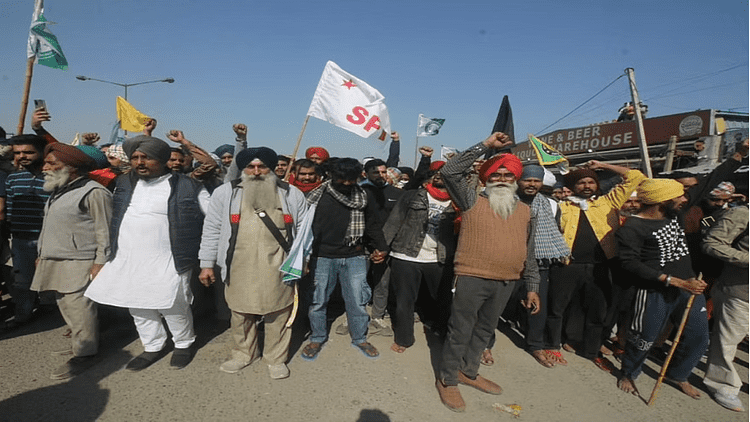Even as farmers from northern states, spearheaded by the farmers from Punjab, braved tear gas and water cannons in the freezing cold of the North, India feels the pulse of simmering discontent and the gathering of hope.
The sheer resistance and the might with which the Centre and the states allied to crush dissenting farmers at each state border are not without significance.
Yet the organizational strength and solidarity of the farmers marching to Delhi to make their voices heard have surprised observers. The march is a concerted and collective action of farmers’ organizations across ideologies and includes small, medium, marginal and big farmers. It has been successful in drawing its support base across rural classes and may be even across caste lines. This is no sporadic protest.
The contentious farm bills that aimed at agriculture market reforms were passed in Parliament with great haste in September this year despite opposition from many quarters. Across various political spectrums, there were worries about corporatization of agriculture, collapse of the present mandi network structure and erosion of the system of minimum support prices. But the Government was not interested in deliberations or scrutiny of the Bills in parliamentary committees.
The growing capitalist tendencies and class differentiation in the agrarian sector has accentuated inequalities. The claims of the Centre that farm laws will usher a new era in agricultural growth with doubling of farmers’ incomes, eliminate middlemen and herald new technology in farming have not found acceptance among the farmers. The question arises if the BJP’s farming policies are a conscious move to deepen agro-capitalism and centralization?
Can agriculture be turned into an industry? The intent of the legislations has been suspect. Since the impact of the laws will be greatest for farmers in Punjab and Haryana, it is only natural that the agitation be spearheaded by them. Consequently, the farmers have blocked roads, disrupted rail traffic and organized massive rallies in Punjab and Haryana. However, the relentless mobilization for two months saw no serious political engagement or initiative by New Delhi.
In the many talks with the Centre to end the deadlock, the agenda of the farmers was dismissed as misplaced anxiety. There was deafening silence over the assurance sought by farmers for making minimum guarantee of prices as a legal right. The inconclusiveness of the deliberations pushed the farmers’ bodies to carry on with the pan India call for ‘Dilli Chalo’ march.
Borders have turned into battlegrounds. The porous borders have been sealed for protesters disabling them from entering the national capital Delhi, which is also the political capital of the country.
The brutal use of state machinery to halt the peaceful protest has been unprecedented. The way Haryana police used common military tactics to dig trenches, install barbed wires and barricades and sand laden trucks, to stall the movement of the farmers is a naked display of state power. The state also approved the use of aerial surveillance through drones to monitor the Singhu and Tikri border where farmers are camping peacefully. The heavy deployment of police and paramilitary forces at the borders and in Delhi, the suspension of metro services in the NCT region, the arrest of farmer leaders into preventive custody is the new face of escalating crackdown. The enhanced power of the state vis-a vis its citizens has only deepened the crisis of democracy in India.
Mostly the farmers have been rallying at the borders of Delhi, adamant to march to Jantar Mantar for making their presence felt. This they believe will translate into articulation of their demands among the highest echelons of power. Why were the stakeholders like them not consulted prior to the law making process is an intriguing question, they ask.
They are wary of any negotiations with the Centre based on conditionalities. The passivity of farmers is a story of the past. Political consciousness of the peasantry is a formidable force to reckon with. In fact, the bargain that the farmers unions want to strike is steered towards institutionalizing farmers’ power in decision-making.
The Centre at this point may not budge on major reform in the laws except for some cosmetic changes and hesitant promise to tweak the MSP regime. The game-changer will be if farmers can ride on the government’s apprehension of a massive rural upheaval in the offing and negotiate for their agency in policy making.
The political opportunity in the protest cannot subvert their role as the vanguard of the movement. Politicization of the farm laws has made zero impact on the legislature to redraw the fate of the farmers. The farmers have forsaken political intervention of parties disallowing eclipsing of their autonomy.
BJP and Congress in Punjab and Haryana have interlocked themselves in accusing each other for misleading the farmers for political gain. The narrative of Khalistan has also been marketed to delegitimize the movement as seeking a secessionist goal. In Delhi, Aam Admi Party led govt. rejected the plea of the Delhi police – acting at the behest of the Central government – to convert nine stadiums in the city into jails to lodge protesting farmers, reiterating that protesting in a non-violent way is the constitutional right of every citizen.
The evocation of social solidarity and new networks of social capital can hardly be missed. The volunteers setting up free health clinics, free distribution of masks and food distribution are moments of hope in this crisis of despotism. The momentum of the protest has to be nurtured to kill any lull that may set in with the passing of time.
The shift from rural unionism to effective political consciousness may become the mantra for a successful agrarian mobilization in this case. Perhaps, when citizens groups join the protest at Jantar Mantar, the transformative potential of the movement will be tested. The condescending majority who decided the fate of the farmers may finally feel challenged if the farmers stand their ground. It’s time to hear the voices of those who feed the nation.
































